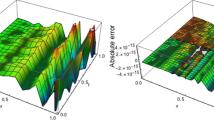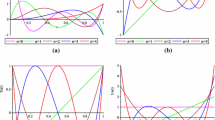Abstract
This paper presents a semi-analytical wavelet-based approach for stability analysis of time-periodic delay-differential equations (DDEs) with a single discrete time delay. By using the autocorrelation functions of compactly supported Daubechies scaling functions, the DDE is discretized to a set of algebraic equations, employing the wavelet collocation method. The state transition matrix over a single period is constructed to determine the stability based on Floquet theory. Stability charts for the one-degree-of-freedom milling model and time-delayed Mathieu equation are obtained, illustrating both the efficiency and accuracy of the proposed approach.




Similar content being viewed by others
References
Stépán, G.: Retarded Dynamical Systems: Stability and Characteristic Functions. Longman Scientific & Technical, New York (1989)
Balachandran, B.: Nonlinear dynamics of milling processes. Philos. Trans. Math. Phys. Eng. Sci. 359(1781), 793–819 (2001)
Wiercigroch, M., Budak, E.: Sources of nonlinearities, chatter generation and suppression in metal cutting. Philos. Trans. R. Soc. A Math. Phys. Eng. Sci. 359(1781), 663–693 (2001)
Altintas, Y.: Manufacturing Automation: Metal Cutting Mechanics, Machine Tool Vibrations, and CNC Design. Cambridge University Press, Cambridge (2000)
Altintas, Y., Weck, M.: Chatter stability of metal cutting and grinding. CIRP Ann. Manuf. Technol. 53(2), 619–642 (2004)
Altintas, Y., Budak, E.: Analytical prediction of stability lobes in milling. CIRP Ann. Manuf. Technol. 44(1), 357–362 (1995)
Budak, E., Altintas, Y.: Analytical prediction of chatter stability in milling—part I: general formulation. J. Dyn. Syst. Meas. Control Trans. ASME 120(1), 22–30 (1998)
Insperger, T., Stépán, G.: Semi-discretization method for delayed systems. Int. J. Numer. Methods Eng. 55(5), 503–518 (2002)
Insperger, T., Stépán, G.: Updated semi-discretization method for periodic delay-differential equations with discrete delay. Int. J. Numer. Methods Eng. 61(1), 117–141 (2004)
Insperger, T., Stépán, G., Turi, J.: On the higher-order semi-discretizations for periodic delayed systems. J. Sound Vib. 313(1–2), 334–341 (2008)
Long, X.H., Balachandran, B.: Stability analysis for milling process. Nonlinear Dyn. 49(3), 349–359 (2007)
Long, X.H., Balachandran, B., Mann, B.P.: Dynamics of milling processes with variable time delays. Nonlinear Dyn. 47(1–3), 49–63 (2007)
Insperger, T., Stépán, G.: Semi-discretization for Time-Delay Systems: Stability and Engineering Applications. Springer, New York (2011)
Bayly, P.V., Halley, J.E., Mann, B.P., Davies, M.A.: Stability of interrupted cutting by temporal finite element analysis. J. Manuf. Sci. Eng. Trans. ASME 125(2), 220–225 (2003)
Breda, D., Maset, S., Vermiglio, R.: Computing the characteristic roots for delay differential equations. IMA J. Num. Anal. 24(1), 1–19 (2004)
Breda, D., Maset, S., Vermiglio, A.R.: Pseudospectral differencing methods for characteristic roots of delay differential equations. SIAM J. Sci. Comput. 27(2), 482–495 (2006)
Ding, Y., Zhu, L., Zhang, X., Ding, H.: A full-discretization method for prediction of milling stability. Int. J. Mach. Tools Manuf. 50(5), 502–509 (2010)
Quo, Q., Sun, Y., Jiang, Y.: On the accurate calculation of milling stability limits using third-order full-discretization method. Int. J. Mach. Tools Manuf. 62, 61–66 (2012)
Liu, Y., Zhang, D., Wu, B.: An efficient full-discretization method for prediction of milling stability. Int. J. Mach. Tools Manuf. 63, 44–48 (2012)
Niu, J., Ding, Y., Zhu, L., Ding, H.: Runge–Kutta methods for a semi-analytical prediction of milling stability. Nonlinear Dyn. 76(1), 289–304 (2014)
Olgac, N., Sipahi, R.: A unique methodology for chatter stability mapping in simultaneous machining. J. Manuf. Sci. Eng. Trans. ASME 127(4), 791–800 (2005)
Olgac, N., Sipahi, R.: Dynamics and stability of variable-pitch milling. J. Vib. Control 13(7), 1031–1043 (2007)
Ding, Y., Zhu, L., Zhang, X., Ding, H.: Numerical integration method for prediction of milling stability. J. Manuf. Sci. Eng. Trans. ASME 133(3), 031005 (2011). doi:10.1115/1.4004136
Li, M., Zhang, G., Huang, Y.: Complete discretization scheme for milling stability prediction. Nonlinear Dyn. 71(1–2), 187–199 (2013)
Butcher, E.A., Ma, H., Bueler, E., Averina, V., Szabo, Z.: Stability of linear time-periodic delay-differential equations via Chebyshev polynomials. Int. J. Numer. Methods Eng. 59(7), 895–922 (2004)
Butcher, E.A., Bobrenkov, O.A., Bueler, E., Nindujarla, P.: Analysis of milling stability by the Chebyshev collocation method: algorithm and optimal stable immersion levels. J. Comput. Nonlinear Dyn. 4(3), 031003 (2009)
Ding, Y., Zhu, L., Zhang, X., Ding, H.: Stability analysis of milling via the differential quadrature method. J. Manuf. Sci. Eng. Trans. ASME 135(4), 044502 (2013)
Suh, C.S., Khurjekar, P.P., Yang, B.: Characterisation and identification of dynamic instability in milling operation. Mech. Syst. Signal Process. 16(5), 853–872 (2002)
Choi, T., Shin, Y.C.: On-line chatter detection using wavelet-based parameter estimation. J. Manuf. Sci. Eng. Trans. ASME 125(1), 21–28 (2003)
Yoon, M.C., Chin, D.H.: Cutting force monitoring in the endmilling operation for chatter detection. Proc. Inst. Mech. Eng. Part B J. Eng. Manuf. 219(6), 455–465 (2005)
Strang, G., Nguyen, T.: Wavelets and Filter Banks. Wellesley-Cambridge Press, Wellesley (1996)
Bertoluzza, S., Naldi, G.: A wavelet collocation method for the numerical solution of partial differential equations. Appl. Comput. Harmon. Anal. 3(1), 1–9 (1996)
Deslauriers, G., Dubuc, S.: Symmetric iterative interpolation processes. Constr. Approx. 5(1), 49–68 (1989)
Zhou, J., Zhou, Y.H., Liew, K.M.: Wavelet-based method for stability analysis of vibration control systems with multiple delays. Comput. Mech. 47(2), 161–170 (2011)
Beylkin, G., Saito, N.: Wavelets, their autocorrelation functions, and multiresolution representations of signals. In: Proceedings of the SPIE, pp. 39–50. The International Society for Optical Engineering (1993)
Horn, R.A., Johnson, C.R.: Topics in Matrix Analysis. Cambridge University Press, Cambridge (1991)
Farkas, M.: Periodic Motions. Springer, New York (1994)
Insperger, T., Stépán, G.: Stability chart for the delayed Mathieu equation. Proc. R. Soc. A Math. Phys. Eng. Sci. 458(2024), 1989–1998 (2002)
Insperger, T., Stépán, G.: Stability of the damped Mathieu equation with time delay. J. Dyn. Syst. Meas. Control Trans. ASME 125(2), 166–171 (2003)
Mallat, S.: A Wavelet Tour of Signal Processing: The Sparse Way, 3rd edn. Academic Press, Burlington (2009)
Acknowledgments
This work was partially supported by the National Natural Science Foundation of China (Grant Nos. 51305263 and 51325502). The last author was supported by the National Key Basic Research Program (Grant No. 2011CB706804).
Author information
Authors and Affiliations
Corresponding author
Appendices
Appendix A: Multiresolution analysis and Daubechies scaling function [40]
A multiresolution analysis is a sequence \(\{V_J\}, J\in {\mathbb {Z}}\) of subspaces of \(L^{2}(\mathbb {R})\) with the following properties:
The Daubechies scaling function, \({\varphi } (t)\), with \(M\) vanishing moments, is constructed by applying the iterative procedure [40]
where \(h_k\) are the Daubechies filter coefficients (Table 2). The set \(\{ {\phi (t-k),k\in {\mathbb {Z}}}\}\) is an orthonormal basis for \(V_0 \). The support of the scaling function \({\varphi } (t)\) is \([0,L]\), and \(L=2M-1\), where the support of \({\varphi } (t)\) means an interval \(P\) such that \({\varphi } (t)=0\), for \(t \notin P\).
The corresponding Daubechies wavelet function \(\psi (t)\) can be expressed as
The Daubechies wavelet function has the following property, i.e.,
where it means \(\psi (t)\) has its first \(M\) moments vanish.
Appendix B: Formulation of the single DOF milling system
The governing equation of the single DOF milling system can be formulated as [9]
where \(\zeta \) is the relative damping, \(\omega _\mathrm{n}\) is the angular natural frequency, \(m_t\) is the modal mass of the cutter, \(a_p\) is the depth of cut, and \(h(t)\) is the cutting force coefficient.
By denoting that \(y(t)=m_t\frac{\hbox {d}}{\hbox {d}t}x(t)+m_t \zeta \omega _n x(t)\) and \({\mathbf{x}}(t)=[x(t) \quad y(t)]^\mathrm{T}\), Eq. (38) can be represented as the state-space form, i.e.,
where
Rights and permissions
About this article
Cite this article
Ding, Y., Zhu, L. & Ding, H. A wavelet-based approach for stability analysis of periodic delay-differential systems with discrete delay. Nonlinear Dyn 79, 1049–1059 (2015). https://doi.org/10.1007/s11071-014-1722-5
Received:
Accepted:
Published:
Issue Date:
DOI: https://doi.org/10.1007/s11071-014-1722-5




